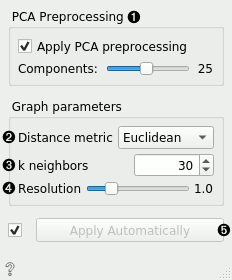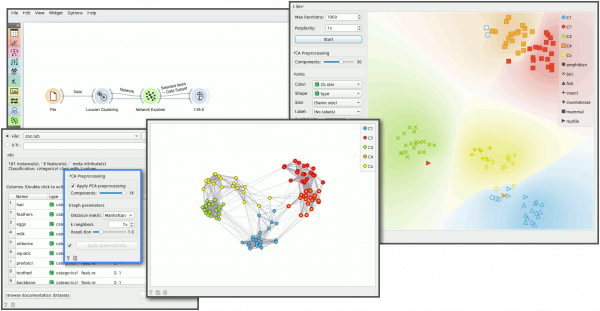Orange: Louvain Clustering
Sumber: https://docs.biolab.si//3/visual-programming/widgets/unsupervised/louvainclustering.html
Widget Louvain Clustering mengelompokan item menggunakan algoritma Louvain clustering.
Input
Data: input dataset
Output
Data: dataset with cluster index as a class attribute Graph (with the Network addon): the weighted k-nearest neighbor graph
Widget Louvain Clustering mengubah data input menjadi k-nearest neighbor graph. Untuk mempertahankan gagasan distance, Jaccard index untuk jumlah shared tetangga digunakan untuk menentukan batas (edge). Akhirnya, algoritma pendeteksian optimisasi komunitas modularitas diterapkan pada graph untuk memperoleh cluster dari node yang highly interconnected. Widget mengeluarkan set data baru di mana cluster index digunakan sebagai atribut meta.
- PCA processing is typically applied to the original data to remove noise.
- The distance metric is used for finding specified number of nearest neighbors.
- The number of nearest neighbors to use to form the KNN graph.
- Resolution is a parameter for the Louvain community detection algorithm that affects the size of the recovered clusters. Smaller resolutions recover smaller, and therefore a larger number of clusters, and conversely, larger values recover clusters containing more data points.
- When Apply Automatically is ticked, the widget will automatically communicate all changes. Alternatively, click Apply.
Contoh
Widget Louvain Clustering mengkonversi dataset menjadi graph, dimana widget Louvain Clustering akan menemukan highly interconnected node. Kita bisa memvisualisasi graph yang dihasilkan menggunakan Widget Network Explorer dari Network addon.
Referensi
Blondel, Vincent D., et al. “Fast unfolding of communities in large networks.” Journal of statistical mechanics: theory and experiment 2008.10 (2008): P10008.
Lambiotte, Renaud, J-C. Delvenne, and Mauricio Barahona. “Laplacian dynamics and multiscale modular structure in networks.” arXiv preprint, arXiv:0812.1770 (2008).

